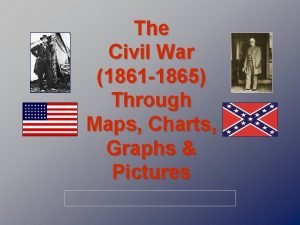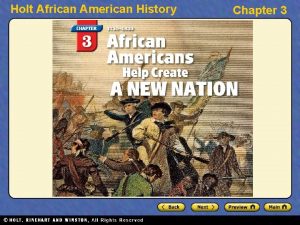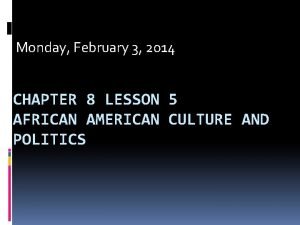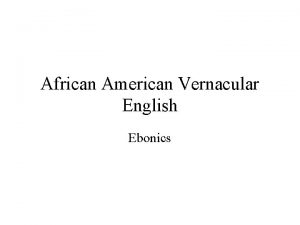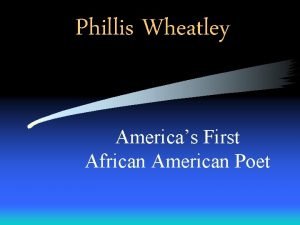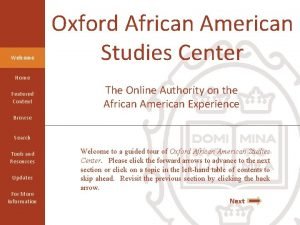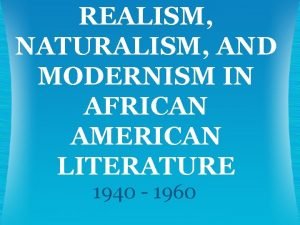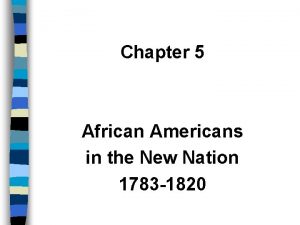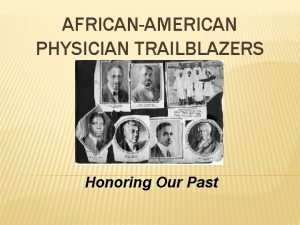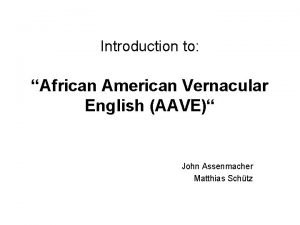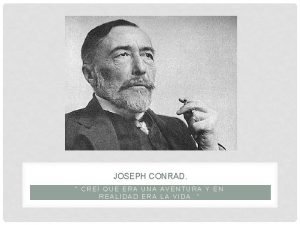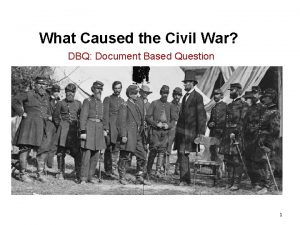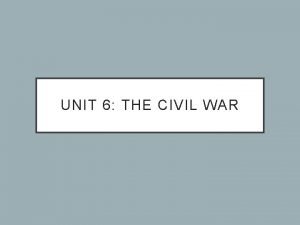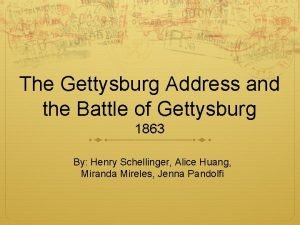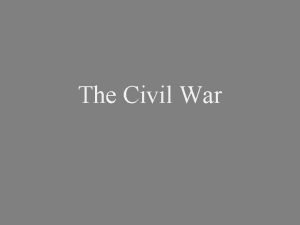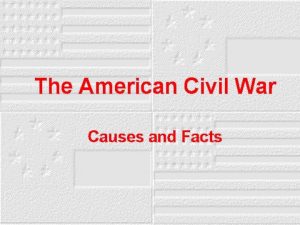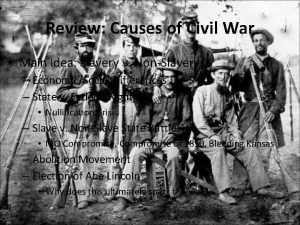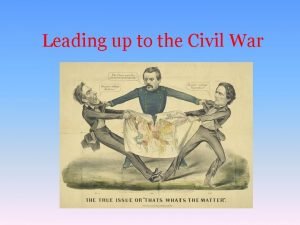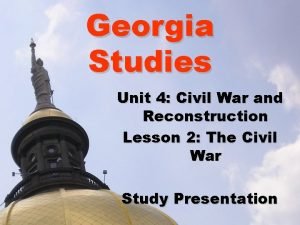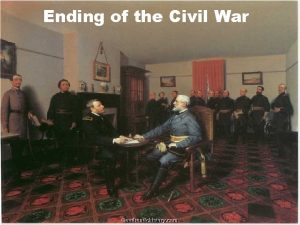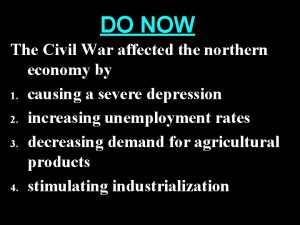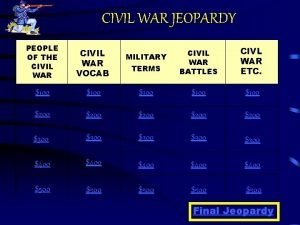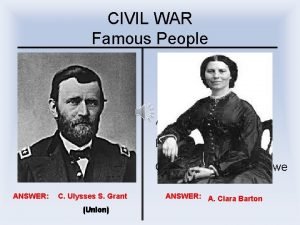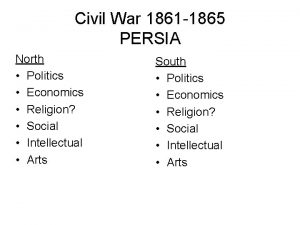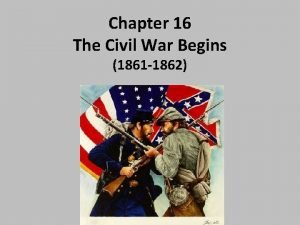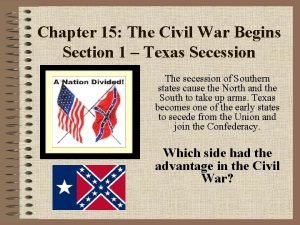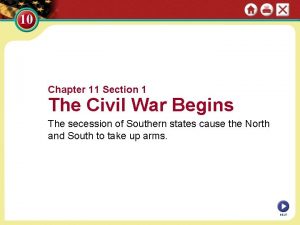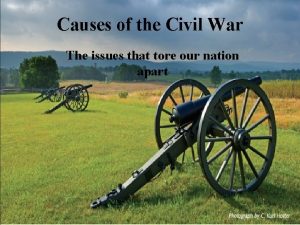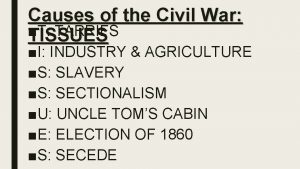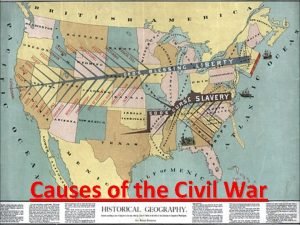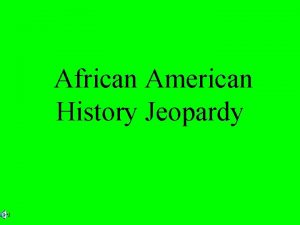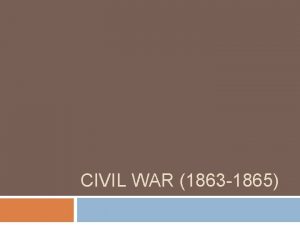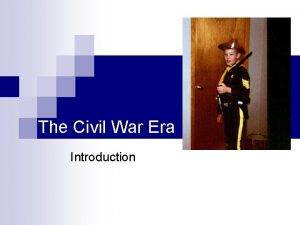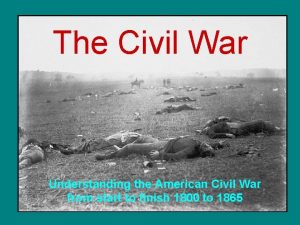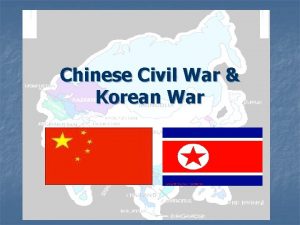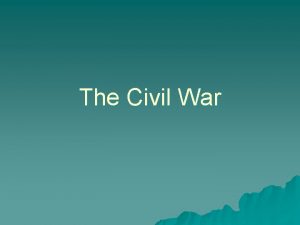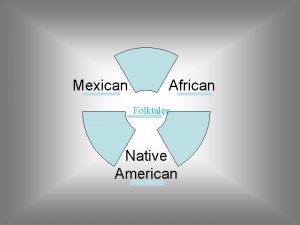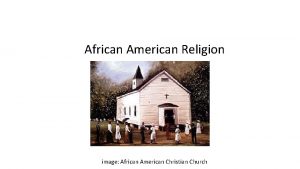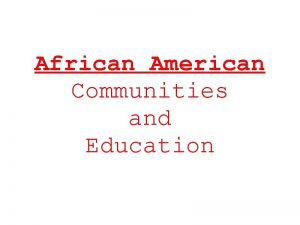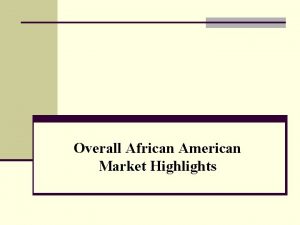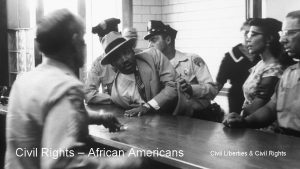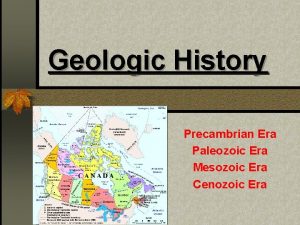History 201 African American History Civil War Era





















































- Slides: 53

History 201 • African American History • Civil War Era Slavery • Reconstruction and the Nadir • of Race Relations • in America

Introduction • Past 50 yrs much ink has been spilled defining, explaining, and trying to come to grips with the “Peculiar Institution. ” • Termed first appeared around 1850 s—some of it fact and some of it fiction.

Causes of Civil War • Many issues will create a volatile atmosphere; westward expansion, manifest destiny, the Mexican War, the several Mo. Compromises; • the Tariff is more of a modern view point than one of reality for the era—

Causes Cont’d • The Tariff was a true bone of contention during the Nullification crises— a ten% decrease in the original tariff was placed into the 1830 Mo. Compromise. • By 1845 it had crept back up to within 20% of the Tariff of Abominations—the southerners cried foul; Walker Tariff of 1847 began a downward trend which again the Walker Tariff of 1857 lowered it over half of the original tariff of 1828 and the Morrill Tariff of 1861 put the tariff at a low ebb that would remain for years and years—

Causes Cont’d Hard to believe that a people would go to war over an issue that in essence was a nonissue—if one is gaining concessions—why then did the argument remain so harsh and volatile—obviously the argument was over something much deeper and emotional. This something was Slavery.

Antebellum Slavery African American slavery can be divided into two periods: 1) Colonial years, about 1650— 1790; 2) From the invention of the Cotton Gin (1793) until the end of the Civil War (1865) with the defeat of the South and the ratification of the 13 th amendment which stated that “neither slavery nor involuntary servitude, except as punishment for crime—shall exist in the United States or any place subject to its jurisdiction. ”

Antebellum Slavery—North With the arrival of Independence northern states began to regard slavery as an unnecessary evil—the true nature of the American economy should be based on diversification—slavery was contradictory to the ideals of the revolution—(NW Ordinance, State constitutions, and Seasonal economies). Northern states began to emancipate slaves. Where they did not emancipate, once the slaves died or moved to other areas the institution would not be replaced— slavery was rapidly evaporating in the North due to emancipation or attrition. (John Adams Philosophy)

North Cont’d By 1820, there were only 3, 000 slaves in the North and almost all of them on large farms in New Jersey—slavery was easily abolished in the north because there were never a tremendous number nor was slave labor a vital component of the northern economy. In the beginning in the north before the abolitionist’s attitude began to permeate northern society, the demand for immediate emancipation of northern slavery was because the white laborers did not want to compete with slaves for their jobs.

Southern Slavery The South was a different story. The African American population both slave and free was much larger in the South—Virginia and South Carolina alone accounted for nearly half of the slave population in the South—

Economic Considerations • the South was dependent upon slave labor because of its singularly focused agriculture economy— • In the upper South, the economy changed from tobacco and tide water rice (cotton never did well beyond North Carolina) especially in Va. to wheat, rye, and corn—

Lower South • Expanded into a more labor intensive economic system; • Also began to expand westward; • Ready market because of the surplus of Upper South Slaves—Profitable Internal Slave trade. • the term to be sold down river carried many connotations

Upper South • There was a relaxation in manumission laws • not always for benevolent reasons—Old and infirm slaves were emancipated and had to fend for themselves—

Expansion of Slavery • Two major events took place to change the institution of slavery: • 1) The Cotton Gin, Eli Whitney, 1793—now slavery could pay its way economically. • 2) Termination of the International Slave trade— Not just slavery but the trade itself became very profitable.

Agriculture and Economic Reasons • The cotton gin changed all that—short staple cotton could now be grown throughout the lower and western southern states—vast new plantations and westward expansion created the states of Alabama, Mississippi, Louisiana and Texas and Arkansas—this alluvial farm land was ideal for growing cotton and the climate was also perfect.

Supply and demand • In 1810, the South produced 85, 000 pounds of cotton; by 1860, it was producing well over 2 billion pounds a year. Unfortunately because of the lack of perspicacity either on the Southern or Northern part, the international slave trade was outlawed in 1808—(Cotton Market values rose from 12 million (1810)to 248 million per year(1860)) • This restricted the supply, because of growing demand, prices went sky-high—many made money off the trade itself, rather than agronomics. • This separates colonial slavery from Antebellum slavery.

Expansion of Slavery • Slavery not monolithic—about 4. 8% of white southern families owned slaves. (Myth: Whites outnumbered Blacks). • In 1860— 10, 000 families owned more than 50 slaves; across the South. • 3, 000 families owned more than a 100 slaves; the typical southern slave owner owned 2 -5; typical white southerners owned none.

Typical White Southern Demographics • The typical southern male was an artisan, mechanic, and more typical a small farmer and needed little labor—this accounts for the large number of small slaveowners—and again many did not own slaves —Yet over a million white male southerners went to war to defend slavery in 1861.

Constitutional Basis • Slavery was the basis of their economy, social fabric and more importantly that some historians ignore but I believe explains the issue much more clear—it was tied to the age old Lockeian theory of life, liberty, and property—

Irresolute Southerners • Richmond politicians stated in the Richmond Enquirer, (1864 -65) “it is absurd to pretend that a government desirous of restoring the Union would adopt such measures as the confiscation of private property, the emancipation of slaves, the division of a sovereign state without its consent. ” (Shelby Foote page 884 Vol II) the struggle must be renewed between generations yet unborn >…

Lincoln’s Compromise • In 1864, Southern politicians in Richmond cast aspersions at reconciliation: • 10% of the population had to swear a loyalty oath to the US government, lay down arms and guarantee emancipation for the slaves—and they would be welcomed back into the Union—nothing no more harsh than that.

Lincoln’s Compromise • Lincoln and concessions-Union reunited important— • Secessionists would not hang as traitors but must abolish slavery— • Lincoln had matured as a politician and had become a great President. • By 1863 understood war was about slavery—eradicate this poisonous issue.

Southern Angst • Some areas of the South had more slaves than free whites and that could be a volatile situation—The Stono Rebellion • St. Andrews Parish in Georgia suffered from several violent slave revolts—Gabriel Prosser and Denmark Vesey in South Carolina also aroused fears in whites and the most notorious was Nat Turner in Virginia—but there were 100 s of smaller revolts and violent outrages against slavery and the institution by slaves themselves—

Slave Codes • To police and regulate the slave population—they formed Slave Patrols and enacted ‘Slave codes. ” • The idea behind the codes was to try and prevent resistance or rebellion—they made it illegal for slaves to read and write, they could not attend church unsupervised, could not testify against a white person in court—

Slave labor • Slave labor in the upper South was much different from the lower South—enjoyed more freedom— often worked at their own pace and often without white supervision— Many slave owners allowed slaves to hire their own time and live in the towns and industrial areas and find their own work—this benefited the slave owner because he could now make a profit off his slaves by hiring them out and lessen the cost of up keep—

Slave Labor/Upper South • The slave had more independence; • make his own money for extra work etc. . . • Keep in mind, however, they existed by the permission of their masters—.

Labor Deep South • Labor in the deep South was brutal and very hard —slaves worked from before sun up until after dark; longer during harvest or planting season— • the buying and selling of slaves was influenced by the economy—

Economic Issues • slaves though treated as family in some homes were always subject to the market economy— • they were instant cash; • economics always trumped morality.

Diversification of Slave Labor • The South was overwhelmingly agriculture and rural. • In fact, however, slaves were used successfully in factories and industry throughout the South; • most industry focused around Cotton, tobacco, and Iron foundries.

Diversification Cont’d • By the time of the war, however, 250000 slaves worked in industry —Richard Wade and Robert S. Starobin did the ground breaking work on Industrial Slavery in the Old South— • As industry grew in the South, owners were finding new ways to use slavery for profit. • Tredegar Iron works in Richmond employed many slaves—Other Iron foundry’s employed slave labor, coal mining and all forms of manufacturing such as cotton textiles, tobacco and transportation industries.

Diversification • The Chicopee and Athens Cotton Factory employed slaves mostly women and children and they worked along side white coworkers— • Thomas R. R. Cobb hired out his slaves to industry and hired Irish workers to do the agriculture duties— it was more profitable.

Slave Artisans and Mechanics • Many slaves by hiring out their own time could make money and eventually many would buy themselves and family out of slavery.

Black Slave Owners • high profile cases of Blacks owning Blacks; • William Ellis; a Mechanical Engineer and Mechanic. • Designed Cotton Gins, built them and serviced them; • Though an aberration to the system, it was an instance where white southerners could point to the righteousness and success of the system • (Robert M. Grooms)

Black Slave Owners • Justus Angel and Mistress L. Horry, of Colleton District, South Carolina, who each owned 84 slaves in 1830. • In fact, in 1830 a fourth of the free black slave masters in South Carolina owned 10 or more slaves; eight owning 30 or more (2).

Black Slave Owners • The country's leading African American historian, Duke University Professor John Hope Franklin, records that in New Orleans over 3, 000 free Blacks owned slaves; • In 1860 Louisiana six African Americans owned 65 or more slaves. The largest number, 152 slaves, were owned by the widow C. Richards and her son P. C. Richards, who owned a large sugar cane plantation. • Antoine Dubuclet, a sugar planter whose estate was valued at (in 1860 dollars) $264, 000 owned 100 slaves. That year, the mean wealth of southern white men was $3, 978.

Black Slave Owners • Black Confederates and Afro-Yankees in Civil War Virginia (University Press of Virginia-1995) was written by Ervin L. Jordan Jr. , an African-American and assistant professor and associate curator of the Special Collections Department, University of Virginia library. He wrote: "One of the more curious aspects of the free black existence in Virginia was their ownership of slaves. Black slave masters owned members of their family and freed them in their wills. Free blacks were encouraged to sell themselves into slavery and had the right to choose their owner through a lengthy court procedure. "

Legal Clout • The general practice of the period was that plantation owners would buy seed and equipment on credit and settle their outstanding accounts when the annual cotton crop was sold. • Ellison resorted to the courts for enforcement of the terms of contract agreements. Several times Ellison successfully sued white men for money owed him.

So, Why Fight? • The ideals of democracy were very limited—the rich planters had a great deal of influence and power over the yeoman farmers and poor whites— this is why James Oakes calls the southern political system the Slavocracy—if you look at the demographics of southern political leaders almost all of them were slave owners and were determined to keep the institution viable and active.

Cont’d • Though not everyone owned slaves is true, it was always a possibility to become a slave owner. • Slave Ownership was a status of making it economically. • It was the basis of success in Southern society; it was the southern way of life, the American dream as they saw it—the road to success was slavery, simply because the economy was slave based.

Cont’d • Alexander Stephens Vice President of the Confederacy said it best in 1861: • “If Slavery is wrong, then the southern way of life is wrong. ” • Slavery in the antebellum South made a small minority of whites very wealthy while exploiting southern blacks and impoverishing many poor whites. • It left many uneducated and retarded the over all growth of the economic, cultural and social growth of the region.

Conclusion • Slavery was the institution by which the South defined itself; But it was the existence of slavery, with its negative impact on politics, economics, and social relations, which fatally crippled the South in its bid for independence. • Jefferson Davis lamented after the war: “The South died of a theory, ” and an arrogance of superiority.

National Issues Linked to Slavery Missouri Compromises of 1820 and 1830 The constitution forbid government interference with slavery where it already existed—abolitionists hoped to prevent its expansion into the territories Missouri sought to enter the union in 1818 as a slave state—this upset the political balance between free soil and slave states— admitted Maine as a free soil state and Mo. As a slave state to maintain the senatorial balance—Remember Alabama had entered as a slave state (1819)–the Senate was perfectly balanced.

Compromised Cont’d • The issue was the territory acquired through the Louisiana Purchase (1803) and what would be acquired through the Mexican War (1846 -47) a few years later. • The rub was the Compromise also provided that slavery would be excluded from the newly settled Louisiana territory except below the latitude 36° 30'.

Compromise of 1850 • The Mexican War acquired vast tracts of land in the Southwest— Antislavery forces demanded that slavery be excluded from these new territories—slaveholders agitated to allow for the expansion of slavery into the new territories because the Mo. Compromise of 1820 allowed it below the 36 th parallel—again compromise was reached. • California was admitted as a free state (hurt the South because of the rich Gold deposits)—agreed to Popular Sovereignty in the other territories and enacted a stronger Fugitive Slave Act to appease southerners.

Harriet Beecher Stowe • A literary event that shook the American public—It was an indictment of the slave system and in particular Southerners themselves— • this would decrease the South’s chances of having a foreign power (ally) to intervene on their behalf when the war started.

Kansas-Nebraska Act • This was a bill introduced by Stephen Douglas that introduced the concept of Popular Sovereignty. • Allow the population by ballot to decide on the slavery issue. • It created a political explosion and people who originally had no opinion on slavery now jumped onto the slavery bandwagon

Dred Scott Case • 1857 --Scott sued for freedom on the grounds that Emerson, though since dead, and bequeathed to his wife Sandford, had taken him to a free soil state where slavery was illegal therefore by definition of law he must be free. • The U. S. Supreme Court ruled otherwise—since Scott was not a true American citizen he had no right to sue in local or federal court. Chief Justice Roger B. Taney said “A slave had no rights which a white men need acknowledge

Backlash of Court Decision • Also ruled Congress had no right to ban slavery in the territories; • Concluded that the Mo. Compromise was unconstitutional; therefore repealed. • Slavery was legal and Guaranteed by constitution; congress no authority to arbitrarily illegalize it.

Lincoln – Douglas Debates • The 1858 debates addressed the issue of western slavery; • Douglas believed in Popular Sovereignty; • Lincoln, on the other hand, argued that slavery was “a moral, a social, and a political wrong. ”

Lincoln • Agreed slavery was a moral wrong and argued that it should never expand to the western territories. • However, He did say that where slavery was entrenched it should be left alone. • Later he would change his mind.

Consequences of the Debates • Slavery had to expand to save the southern economy—this reveals how strong slavery was tied to the southern way of life and its economy. This is why the argument that if left alone slavery would have withered and died. The South refused to let the issue die. • The debates also did a couple of other things: First it revealed how unreliable Douglas was as a southern ally—he had said repeatedly that he did not care whether slavery was voted up or down— Southerners needed allies of slavery. • Second—The South understood the Republican party was dangerous to the survivability of slavery and would oppose any expansion.

John Brown’s Raid • South now convinced the North would resort to violent means such as armed insurrection to destroy their way of life. • Regardless of morality, many southerners were not going to sit idly by allow insurrectionists to kill their families. • Southern Militia’s now prepare and become the basis of the Confederate Army

Political Factors • As northern and southern patterns of living diverged so did their political ideas. The North needed a strong central government to provide for a vast internal transportation infrastructure and the fact that land wise the North was more vast— • The southerners were relegated to a small section of the nation if slavery was not to be allowed to expand— expansion would increase their geography, economic structure, political base and slavery on a much larger scale —the South wanted a government weak and unobtrusive.

Into the Abyss • December 20 th 1860, South Carolina signed its Ordinance of Secession; absolved itself of allegiance to the United States. • In the words of John C. Calhoun and Thomas Jefferson (Virginia and Kentucky Resolutions 1790)—asserting States Rights. • (April 12 th 1861, 0430 am—”The Night They Drove Ol Dixie Down—” The Band, 1970).
 Why was the civil war the first modern war
Why was the civil war the first modern war Toward civil war lesson 3 secession and war
Toward civil war lesson 3 secession and war Who were abolitionists
Who were abolitionists Prentice hall african american history
Prentice hall african american history African american cinema history
African american cinema history Holt african american history
Holt african american history Civil rights webquest
Civil rights webquest African american fighter pilots
African american fighter pilots Lesson 5 african american culture and politics
Lesson 5 african american culture and politics African american vernacular english
African american vernacular english Aave english
Aave english First african american poet
First african american poet Oxford african american studies center
Oxford african american studies center Realism naturalism modernism
Realism naturalism modernism Chapter 5 african american in the new nation
Chapter 5 african american in the new nation Beauty academy online course
Beauty academy online course Urban street books
Urban street books African american english teacher
African american english teacher Dr lewis bass
Dr lewis bass African american vernacular english example
African american vernacular english example Era quiz: the baroque era
Era quiz: the baroque era Victorian and elizabethan era
Victorian and elizabethan era Creí que era una aventura y en realidad era la vida
Creí que era una aventura y en realidad era la vida Vi uma estrela tão alta
Vi uma estrela tão alta Causes of the civil war dbq
Causes of the civil war dbq Civil war map activity
Civil war map activity What were some causes of the civil war
What were some causes of the civil war Gettysburg gtech
Gettysburg gtech English civil war timeline
English civil war timeline What led to civil war
What led to civil war Civil war facts
Civil war facts Civil war staar questions
Civil war staar questions Civil war trifold
Civil war trifold Conclusion of the civil war
Conclusion of the civil war Ppt
Ppt Cotton diplomacy
Cotton diplomacy What led to the civil war
What led to the civil war Civil war trading cards project
Civil war trading cards project Unit 4: civil war and reconstruction
Unit 4: civil war and reconstruction What events led to the civil war
What events led to the civil war Civil war map sherman's march to the sea
Civil war map sherman's march to the sea The civil war affected the northern economy by:
The civil war affected the northern economy by: Civil war and reconstruction study guide
Civil war and reconstruction study guide Myjeopardy
Myjeopardy What is gettysburg
What is gettysburg Famous people in the civil war
Famous people in the civil war Civil war advantages and disadvantages chart
Civil war advantages and disadvantages chart Civil war resumes
Civil war resumes Chapter 16 the civil war begins worksheet answers
Chapter 16 the civil war begins worksheet answers Civil war advantages and disadvantages chart
Civil war advantages and disadvantages chart Site:slidetodoc.com
Site:slidetodoc.com What were the 4 main causes of the civil war
What were the 4 main causes of the civil war Tissues causes of civil war
Tissues causes of civil war Northwest ordinance lead to civil war
Northwest ordinance lead to civil war


